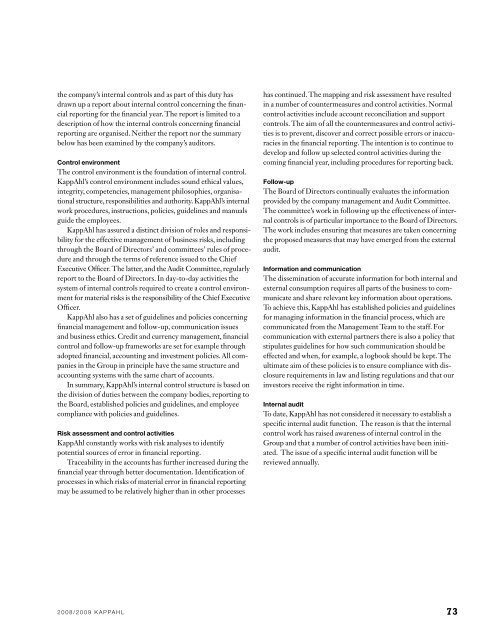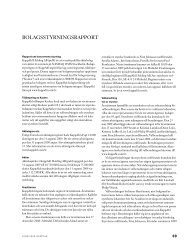We - KappAhl
We - KappAhl
We - KappAhl
You also want an ePaper? Increase the reach of your titles
YUMPU automatically turns print PDFs into web optimized ePapers that Google loves.
the company’s internal controls and as part of this duty has<br />
drawn up a report about internal control concerning the financial<br />
reporting for the financial year. The report is limited to a<br />
description of how the internal controls concerning financial<br />
reporting are organised. Neither the report nor the summary<br />
below has been examined by the company’s auditors.<br />
Control environment<br />
The control environment is the foundation of internal control.<br />
<strong>KappAhl</strong>’s control environment includes sound ethical values,<br />
integrity, competencies, management philosophies, organisational<br />
structure, responsibilities and authority. <strong>KappAhl</strong>’s internal<br />
work procedures, instructions, policies, guidelines and manuals<br />
guide the employees.<br />
<strong>KappAhl</strong> has assured a distinct division of roles and responsibility<br />
for the effective management of business risks, including<br />
through the Board of Directors’ and committees’ rules of procedure<br />
and through the terms of reference issued to the Chief<br />
Executive Officer. The latter, and the Audit Committee, regularly<br />
report to the Board of Directors. In day-to-day activities the<br />
system of internal controls required to create a control environment<br />
for material risks is the responsibility of the Chief Executive<br />
Officer.<br />
<strong>KappAhl</strong> also has a set of guidelines and policies concerning<br />
financial management and follow-up, communication issues<br />
and business ethics. Credit and currency management, financial<br />
control and follow-up frameworks are set for example through<br />
adopted financial, accounting and investment policies. All companies<br />
in the Group in principle have the same structure and<br />
accounting systems with the same chart of accounts.<br />
In summary, <strong>KappAhl</strong>’s internal control structure is based on<br />
the division of duties between the company bodies, reporting to<br />
the Board, established policies and guidelines, and employee<br />
compliance with policies and guidelines.<br />
Risk assessment and control activities<br />
<strong>KappAhl</strong> constantly works with risk analyses to identify<br />
potential sources of error in financial reporting.<br />
Traceability in the accounts has further increased during the<br />
financial year through better documentation. Identification of<br />
processes in which risks of material error in financial reporting<br />
may be assumed to be relatively higher than in other processes<br />
has continued. The mapping and risk assessment have resulted<br />
in a number of countermeasures and control activities. Normal<br />
control activities include account reconciliation and support<br />
controls. The aim of all the countermeasures and control activities<br />
is to prevent, discover and correct possible errors or inaccuracies<br />
in the financial reporting. The intention is to continue to<br />
develop and follow up selected control activities during the<br />
coming financial year, including procedures for reporting back.<br />
Follow-up<br />
The Board of Directors continually evaluates the information<br />
provided by the company management and Audit Committee.<br />
The committee’s work in following up the effectiveness of internal<br />
controls is of particular importance to the Board of Directors.<br />
The work includes ensuring that measures are taken concerning<br />
the proposed measures that may have emerged from the external<br />
audit.<br />
Information and communication<br />
The dissemination of accurate information for both internal and<br />
external consumption requires all parts of the business to communicate<br />
and share relevant key information about operations.<br />
To achieve this, <strong>KappAhl</strong> has established policies and guidelines<br />
for managing information in the financial process, which are<br />
communicated from the Management Team to the staff. For<br />
communication with external partners there is also a policy that<br />
stipulates guidelines for how such communication should be<br />
effected and when, for example, a logbook should be kept. The<br />
ultimate aim of these policies is to ensure compliance with disclosure<br />
requirements in law and listing regulations and that our<br />
investors receive the right information in time.<br />
Internal audit<br />
To date, <strong>KappAhl</strong> has not considered it necessary to establish a<br />
specific internal audit function. The reason is that the internal<br />
control work has raised awareness of internal control in the<br />
Group and that a number of control activities have been initiated.<br />
The issue of a specific internal audit function will be<br />
reviewed annually.<br />
2008/2009 Kappahl 73





